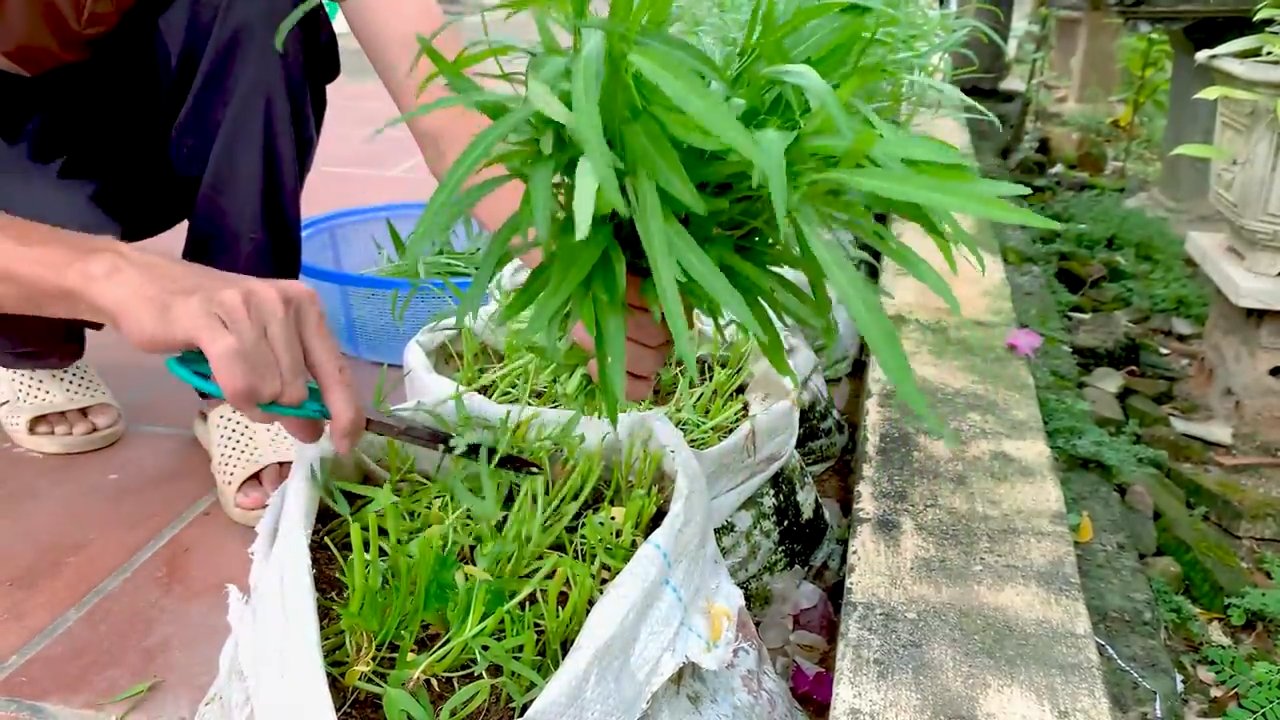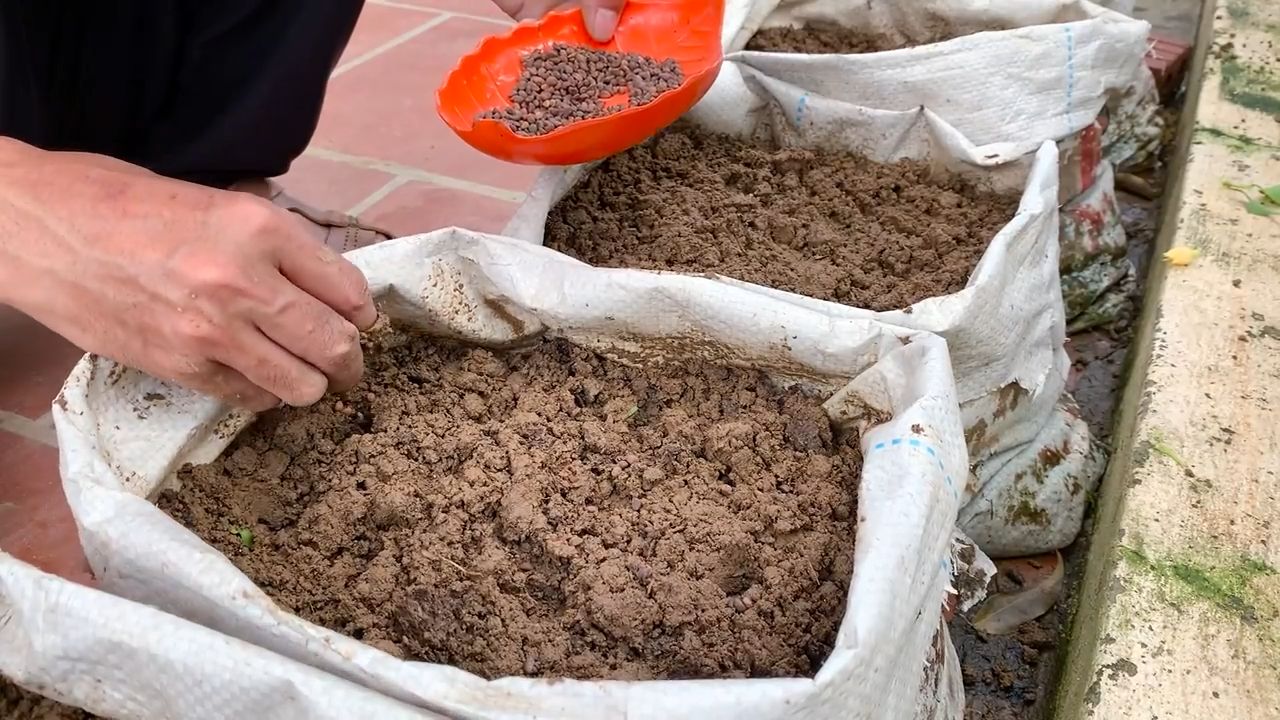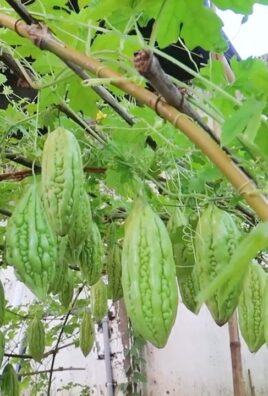Water spinach bucket growing – sounds intriguing, right? Forget sprawling gardens and endless weeding! I’m about to let you in on a little secret that will transform your balcony, patio, or even a sunny windowsill into a thriving oasis of fresh, delicious greens. Imagine harvesting crisp, vibrant water spinach right at your fingertips, ready to add a burst of flavor to your stir-fries, salads, or soups.
For centuries, water spinach, also known as Ong Choy or Kang Kong, has been a staple in Asian cuisine, prized for its nutritional value and delightful taste. But you don’t need to live in the tropics to enjoy this amazing vegetable. This DIY guide will show you how to cultivate your own bountiful supply, no matter where you live.
In today’s fast-paced world, access to fresh, healthy produce can be a challenge. Store-bought vegetables often lack the vibrant flavor and nutritional punch of homegrown varieties. Plus, there’s something incredibly satisfying about nurturing a plant from seed to harvest. That’s where this water spinach bucket growing method comes in. It’s easy, affordable, and incredibly rewarding. I’ll walk you through each step, from choosing the right bucket to harvesting your first batch of delicious water spinach. Get ready to unleash your inner gardener and enjoy the taste of homegrown goodness!

DIY Water Spinach Bucket Garden: A Beginner’s Guide
Hey there, fellow gardening enthusiasts! I’m super excited to share my experience with growing water spinach (also known as kangkong or ong choy) in a bucket. It’s surprisingly easy, incredibly rewarding, and a fantastic way to have fresh, delicious greens right at your fingertips, even if you don’t have a lot of space. This guide will walk you through every step, from gathering your materials to harvesting your bounty. Let’s get started!
What You’ll Need
Before we dive in, let’s gather everything you’ll need. This will make the whole process smoother and more enjoyable.
* A Large Bucket: I recommend a 5-gallon bucket or larger. You can use a food-grade bucket from a bakery or restaurant, or purchase a new one from a hardware store. Just make sure it’s clean!
* Water Spinach Seeds or Cuttings: You can find water spinach seeds online or at some Asian grocery stores. Alternatively, you can use cuttings from mature water spinach plants. Cuttings are usually easier and faster to get started.
* Potting Mix: A good quality potting mix is essential. Avoid using garden soil, as it can become compacted in a bucket.
* Slow-Release Fertilizer: This will provide your water spinach with the nutrients it needs to thrive. I like to use a balanced slow-release fertilizer.
* Water: Obviously! You’ll need plenty of water to keep your water spinach happy.
* Drill (Optional): If your bucket doesn’t have drainage holes, you’ll need a drill to create some.
* Small Rocks or Gravel (Optional): To improve drainage at the bottom of the bucket.
* Sunlight: Water spinach loves sunshine! Choose a location that gets at least 6 hours of direct sunlight per day.
Preparing Your Bucket
This is a crucial step to ensure your water spinach has a healthy growing environment.
1. Clean the Bucket: Thoroughly wash the bucket with soap and water to remove any dirt or residue. Rinse it well.
2. Drill Drainage Holes (If Necessary): If your bucket doesn’t have drainage holes, drill several holes in the bottom. I usually drill about 4-5 holes, each about 1/4 inch in diameter. This will prevent the soil from becoming waterlogged.
3. Add Rocks or Gravel (Optional): Place a layer of small rocks or gravel at the bottom of the bucket. This will further improve drainage and prevent the potting mix from clogging the drainage holes.
4. Fill with Potting Mix: Fill the bucket with potting mix, leaving about 2-3 inches of space at the top. Gently pat down the soil to remove any air pockets.
Planting Your Water Spinach
Now for the fun part – planting! Whether you’re using seeds or cuttings, the process is relatively straightforward.
Planting from Seeds
1. Sow the Seeds: Sprinkle the water spinach seeds evenly over the surface of the potting mix.
2. Cover the Seeds: Lightly cover the seeds with a thin layer of potting mix, about 1/4 inch thick.
3. Water Gently: Gently water the soil to moisten it. Be careful not to wash away the seeds.
4. Keep Moist: Keep the soil consistently moist but not waterlogged. You can cover the bucket with plastic wrap to help retain moisture.
5. Wait for Germination: Water spinach seeds typically germinate within 7-14 days. Once the seedlings emerge, remove the plastic wrap.
Planting from Cuttings
This is my preferred method because it’s faster and often more successful.
1. Prepare the Cuttings: Take cuttings from a mature water spinach plant. The cuttings should be about 6-8 inches long and have several nodes (the points where leaves grow). Remove the lower leaves from the cuttings, leaving only a few leaves at the top.
2. Root the Cuttings (Optional): You can root the cuttings in water before planting them in the bucket. Place the cuttings in a glass of water, making sure the lower nodes are submerged. Change the water every day or two. Roots should start to appear within a week or two. This step isn’t strictly necessary, but it can increase your success rate.
3. Plant the Cuttings: Make small holes in the potting mix, about 2-3 inches deep. Plant the cuttings in the holes, spacing them about 4-6 inches apart.
4. Water Gently: Gently water the soil to moisten it.
5. Provide Support (Optional): If your cuttings are tall and flimsy, you can provide them with some support, such as small stakes or bamboo skewers.
Caring for Your Water Spinach
Water spinach is relatively low-maintenance, but there are a few things you need to do to keep it healthy and productive.
1. Water Regularly: Water spinach loves water! Keep the soil consistently moist, especially during hot weather. I usually water my water spinach bucket every day, sometimes twice a day during the hottest periods.
2. Fertilize Regularly: Water spinach is a heavy feeder, so it needs regular fertilization. Apply a slow-release fertilizer according to the package instructions. You can also supplement with liquid fertilizer every few weeks.
3. Provide Sunlight: Water spinach needs at least 6 hours of direct sunlight per day. Place your bucket in a sunny location.
4. Control Pests and Diseases: Water spinach is generally resistant to pests and diseases, but it can be susceptible to aphids and spider mites. Inspect your plants regularly and take action if you see any signs of infestation. You can use insecticidal soap or neem oil to control these pests.
5. Prune Regularly: Pruning encourages bushier growth and prevents the plants from becoming leggy. Pinch off the tips of the stems regularly to promote branching.
Harvesting Your Water Spinach
This is the moment you’ve been waiting for! You can start harvesting your water spinach about 4-6 weeks after planting.
1. Harvesting Technique: Use scissors or a sharp knife to cut the stems about 6-8 inches from the top. This will encourage the plants to produce new shoots.
2. Harvest Regularly: Harvest your water spinach regularly to keep it producing. The more you harvest, the more it will grow!
3. Enjoy Your Harvest: Water spinach is delicious in stir-fries, soups, and salads. It’s also a great source of vitamins and minerals.
Troubleshooting
Even with the best care, you might encounter some challenges. Here are a few common problems and how to address them:
* Yellowing Leaves: This could be a sign of overwatering, underwatering, or nutrient deficiency. Check the soil moisture and adjust your watering schedule accordingly. If the soil is consistently moist, you may be overwatering. If the soil is dry, you may be underwatering. You can also try fertilizing your plants with a balanced fertilizer.
* Slow Growth: This could be due to insufficient sunlight, poor soil, or lack of nutrients. Make sure your plants are getting enough sunlight and that the soil is well-draining and fertile. You can also try fertilizing your plants with a balanced fertilizer.
* Pests: As mentioned earlier, water spinach can be susceptible to aphids and spider mites. Inspect your plants regularly and take action if you see any signs of infestation. You can use insecticidal soap or neem oil to control these pests.
* Leggy Growth: This is usually caused by insufficient sunlight. Move your plants to a sunnier location or provide them with supplemental lighting. Pruning can also help to encourage bushier growth.
Tips for Success
Here are a few extra tips to help you succeed with your water spinach bucket garden:
* Choose the Right Bucket: Make sure your bucket is large enough to accommodate the roots of the water spinach plants. A 5-gallon bucket is a good starting point, but you may need a larger bucket if you’re growing a lot of plants.
* Use Good Quality Potting Mix: Avoid using garden soil, as it can become compacted in a bucket. A good quality potting mix will provide good drainage and aeration.
* Water Regularly: Water spinach loves water, so keep the soil consistently moist.
* Fertilize Regularly: Water spinach is a heavy feeder, so it needs regular fertilization.
* Provide Sunlight: Water spinach needs at least 6 hours of direct sunlight per day.
* Harvest Regularly: Harvest your water spinach regularly to keep it producing.
* Don’t Be Afraid to Experiment: Gardening is all about experimentation. Don’t be afraid to try different things and see what works best for you.
I hope this guide has been helpful! Growing water spinach in a bucket is a fun and rewarding experience. With a little bit of care, you can enjoy fresh, delicious greens right from your own

Conclusion
So, there you have it! Transforming a simple bucket into a thriving water spinach garden is not only incredibly rewarding but also surprisingly easy. We’ve walked you through the process, highlighting the simplicity and cost-effectiveness of this DIY project. Why spend money on store-bought water spinach when you can cultivate your own fresh, organic supply right at home?
This method offers a multitude of benefits. Firstly, you have complete control over the growing environment, ensuring your water spinach is free from harmful pesticides and chemicals. Secondly, it’s a fantastic way to recycle old buckets and reduce waste. Thirdly, and perhaps most importantly, you’ll experience the unparalleled satisfaction of harvesting your own homegrown vegetables. The taste of freshly picked water spinach, bursting with flavor and nutrients, is simply unmatched.
But the beauty of this DIY water spinach bucket growing method lies in its adaptability. Feel free to experiment with different bucket sizes, nutrient solutions, and even companion plants. Consider adding a small amount of fish emulsion to the water for an extra boost of nutrients. You could also try growing other leafy greens alongside your water spinach, such as lettuce or bok choy, to create a diverse and productive mini-garden. If you live in a particularly hot climate, consider placing your bucket in a partially shaded area to prevent the water from overheating.
Don’t be afraid to get creative and personalize your water spinach bucket garden to suit your specific needs and preferences. The possibilities are endless!
We firmly believe that this DIY water spinach bucket growing trick is a must-try for any gardening enthusiast, regardless of experience level. It’s a fun, educational, and ultimately delicious way to connect with nature and enjoy the fruits (or rather, vegetables) of your labor.
We are confident that you’ll find this method to be both enjoyable and productive. So, gather your supplies, follow our simple steps, and prepare to be amazed by the abundance of fresh water spinach you can grow in a single bucket.
Now, we want to hear from you! Have you tried growing water spinach in a bucket before? What were your experiences? Do you have any tips or tricks to share? We encourage you to give this DIY project a try and share your results with us in the comments below. Let’s build a community of water spinach enthusiasts and learn from each other’s successes and challenges. Your feedback is invaluable and will help us improve this guide for future gardeners. Happy growing!
Frequently Asked Questions (FAQ)
What kind of bucket should I use?
Ideally, you should use a food-grade bucket that is at least 5 gallons in size. This will provide ample space for the water spinach roots to grow. Avoid using buckets that have previously contained chemicals or toxins, as these could contaminate your plants. If you’re unsure about the history of a bucket, it’s best to err on the side of caution and choose a new one. You can often find inexpensive food-grade buckets at hardware stores or online retailers. Make sure the bucket is opaque to prevent algae growth.
What type of soil should I use?
While water spinach can grow in a variety of soil types, a well-draining, nutrient-rich soil is ideal. A good option is a mix of potting soil, compost, and perlite or vermiculite. The potting soil provides a base for the plants to grow, the compost adds essential nutrients, and the perlite or vermiculite improves drainage and aeration. Avoid using heavy clay soils, as these can become waterlogged and suffocate the roots. You can also use a soilless mix specifically designed for hydroponics, which can provide excellent results.
How often should I water my water spinach?
Water spinach thrives in moist conditions, so it’s important to keep the soil consistently damp. Check the soil moisture level daily and water as needed to prevent it from drying out. In hot weather, you may need to water your plants more frequently. The bucket should ideally have a small amount of standing water at the bottom, mimicking the natural environment of water spinach.
What kind of fertilizer should I use?
Water spinach is a heavy feeder, so it’s important to provide it with adequate nutrients. A balanced liquid fertilizer, such as a 20-20-20 formulation, is a good option. Dilute the fertilizer according to the package instructions and apply it every 1-2 weeks. You can also use organic fertilizers, such as fish emulsion or seaweed extract, which are gentler on the environment. Avoid over-fertilizing, as this can burn the roots and damage the plants.
How much sunlight does water spinach need?
Water spinach needs at least 6 hours of direct sunlight per day to thrive. Choose a location for your bucket that receives plenty of sunlight throughout the day. If you live in a particularly hot climate, you may need to provide some afternoon shade to prevent the plants from overheating. If you don’t have access to enough sunlight, you can supplement with artificial grow lights.
How long does it take for water spinach to grow?
Water spinach is a fast-growing vegetable, and you can typically start harvesting leaves within 4-6 weeks of planting. The exact time will depend on the growing conditions, such as temperature, sunlight, and nutrient availability. To encourage continuous growth, harvest the outer leaves regularly, leaving the inner leaves to mature.
How do I harvest water spinach?
To harvest water spinach, simply cut the stems about 4-6 inches from the base of the plant. This will encourage new growth and allow you to harvest multiple times from the same plant. You can harvest the leaves and stems, both of which are edible. Wash the water spinach thoroughly before cooking.
Can I grow water spinach indoors?
Yes, you can grow water spinach indoors, but you will need to provide it with adequate light. Place the bucket near a sunny window or use artificial grow lights to supplement the natural light. You will also need to ensure that the temperature is warm enough, as water spinach prefers temperatures between 70-85°F (21-29°C).
What are some common pests and diseases that affect water spinach?
Water spinach is generally resistant to pests and diseases, but it can be susceptible to aphids, spider mites, and fungal diseases. To prevent pests, inspect your plants regularly and remove any infested leaves. You can also use insecticidal soap or neem oil to control pests. To prevent fungal diseases, ensure that the plants have good air circulation and avoid overwatering.
Is water spinach safe to eat?
Yes, water spinach is safe to eat when grown properly. However, it’s important to source your seeds from a reputable supplier and avoid growing water spinach in contaminated water or soil. Always wash the water spinach thoroughly before cooking to remove any dirt or debris. If you have any concerns about the safety of your water spinach, consult with a healthcare professional.
Can I grow water spinach from cuttings?
Yes, growing water spinach from cuttings is a very effective method. Simply take a cutting from a mature plant, about 6-8 inches long, and remove the lower leaves. Place the cutting in water until roots develop, which usually takes about a week or two. Once the roots are well-established, you can transplant the cutting into your bucket. This is a great way to propagate new plants from your existing water spinach.
How do I prevent algae growth in my water spinach bucket?
Algae growth can be a common problem in water spinach buckets, especially if they are exposed to direct sunlight. To prevent algae growth, use an opaque bucket to block out light. You can also add a small amount of hydrogen peroxide to the water, which will help to kill algae. Regularly clean the bucket to remove any algae that does grow.
What are some variations I can try with my water spinach bucket garden?
There are many variations you can try with your water spinach bucket garden. You can experiment with different types of soil or soilless mixes, different fertilizers, and different companion plants. You can also try growing water spinach in different types of containers, such as plastic tubs or even old tires. Get creative and see what works best for you!
How do I know when my water spinach is ready to harvest?
Your water spinach is ready to harvest when the leaves are about 6-8 inches long and the stems are tender. The leaves should be a vibrant green color and free from any signs of damage or disease. Don’t wait too long to harvest, as the leaves can become tough and bitter if they are allowed to grow too large. Regular harvesting will encourage continuous growth and provide you with a steady supply of fresh water spinach.





Leave a Comment